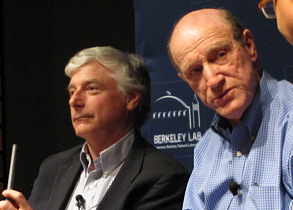Berkeley, April 12, 2011.
Edited video featuring excerpts from Berkeley Lab (LBNL) sponsored discussion ‘Fukushima: Fact Vs. Fiction’ at the David Brower Center. Speakers included 3 Lawrence Berkeley National Laboratory Ph.D. scientists – Robert Budnitz, Thomas McKone, and Edward Morse – who discussed details of the nuclear reactor meltdown crisis which followed the earthquake and tsunami in Japan. The event was moderated by Lance Knobel.
“…those systems failed. And when they failed, quickly, the reactors, all three of them, one after the other, got too hot. Water boiled off, there was no replacement water. The core melted, at least in our estimation, the estimation of the community that looks at this, somewhere between a third and two thirds of the cores melted in all three of those reactors. The exact numbers aren’t really known yet and we’re not going to know until some time later when we get inside. So those cores melted and a lot of the fuel slumped to the bottom.” ~ Robert Budnitz
The discussion focused on many issues and details of the nuclear accident which followed the earthquake and tsunami. Budnitz and McKone described the nuclear fuel rods and how their zirconium coating can oxidize when there is insufficient cooling water inside the reactor core. In the event of a water pump failure (such as follows an electrical blackout), the zirconium coating comes into contact with steam and oxidizes. This took place in the three active Fukushima reactors (as well as in the Three Mile Island accident in 1979). As the zirconium coating oxidized, oxygen atoms were stripped from from the water vapor molecules leaving behind pure hydrogen, an explosive gas which accumulated to dangerous levels and was responsible for the explosions which destroyed the buildings housing two of the reactors. McKone described that if the rods in one of these reactors were to completely oxidize it would produce as much hydrogen gas as 1/15th of a Hindenburg – equivalent in explosive energy to 60 tons of TNT.
 The fuel rods also melted as the accident progressed, and thus Budnitz describes the accident as ‘a meltdown’, with an estimated one third to two thirds of the fuel rods in the three active reactor cores having melted with radiation escaping into the environment. The other three reactors, four five and six, did not experience meltdowns simply because the fuel in the core had already been removed well before the disaster began.
The fuel rods also melted as the accident progressed, and thus Budnitz describes the accident as ‘a meltdown’, with an estimated one third to two thirds of the fuel rods in the three active reactor cores having melted with radiation escaping into the environment. The other three reactors, four five and six, did not experience meltdowns simply because the fuel in the core had already been removed well before the disaster began.
The presence of these spent fuel rods in storage pools inside the reactor buildings has been a complicating factor. According to Robert Budnitz, these spent fuel rods in pools inside the Fukushima reactor buildings were limited to those that were recently removed (less than one year ago) from the reactor cores and as such were still too hot – both in terms of temperature and radioactivity – to have safely been moved to a nearby pool which serves all six reactors for containing rods which are somewhat less ‘hot’. By contrast, in the United States it is common to also store even the cooler rods onsite for many years, though this is a question of policy and is not an engineering requirement.
An additional and bizarre problem was that the hydrogen explosion in reactor three blew the roof completely off – and it landed on top of reactor four. The core of reactor four had been removed last November, but the spent fuel rods were in the storage pool – outside and of containment and still highly radioactive. The extra roof made it difficult to get water to the storage pool and radiation was released.
The health danger from radioactive fallout here in the Bay Area was strongly discounted due to dilution, and even in Japan secondary health effects from stress and factors other than radioactivity were highlighted by some of the panelists.
28:06 “The risks from this technology are apparently greater than we thought. This accident tells us that, that’s for sure. Nobody anticipated this. Whether they’re unacceptable is something the broader society is going to have to figure out I’m not going to speculate on that in fact I’m not even sure we know yet. But that’s for sure, and one of the sort of humbling things is, that despite all the things we do to make these things safe, somehow these – and there were three of them and not just one, so it’s three of them and they were repeated, the same issue – somehow these reactors got into trouble that nobody in the engineering community anticipated would happen in the way it did. So that’s a humbling experience and we’re going to all have to not only eat crow but try to figure out what to do about it”. ~ Robert Budnitz
A complete video of the talk produced by the Berkeley Lab can be seen here: Fukushima: Fact vs. Fiction. Panel Discussion April 12, 2011
Coincidentally, another talk in Canada at the Simon Fraser University the day before touched on similar topics:
The Fukushima Nuclear Crisis: Separating Fact From Fiction
Report by James George



























































